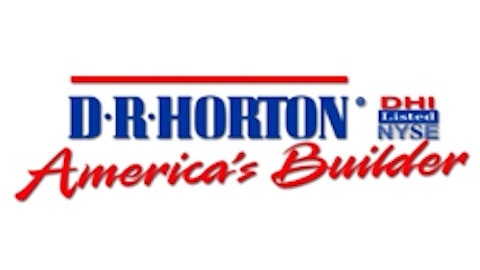Sizable fortunes were already delivered to those who have wisely invested in stocks of American homebuilders last year, judging by the recent rosy results of three of the largest construction services companies in the U.S. What’s even more, these companies’ bull run may have just started, and a full-blown stampede may be in store for a choice few.
Surprises from the big three
The triumvirate of the largest U.S. national homebuilders—Lennar Corporation (NYSE:LEN), PulteGroup, Inc. (NYSE:PHM), D.R. Horton, Inc. (NYSE:DHI) — reported robust results in their latest quarterly performance all of which exceeded stock analysts’ expectations.

Another top U.S. national homebuilder, the Bloomfield Hills, Michigan-based Pulte, likewise reported that its net income for the 2012 fourth quarter ballooned to $59 million, or $0.15 per share, from the 2011 fourth quarter of $14 million, or $0.04 per share. Pulte’s earnings in the 2012 fourth quarter were generated on sale revenues of $1.5 billion, up 27% from the previous year’s fourth quarter. The revenue growth drivers include a 20 percent increase in closed deals on 5,154 homes and a 6 percent increase in selling prices. The company’s profitability also benefited from cost controls and value-creation initiatives.
D.R. Horton, with national operations approximating those of Lennar and Pulte, likewise posted double-digit gains in its fiscal 2013 first quarter. This company which operates in 26 states and 77 metropolitan markets across the United States posted net earnings of 20 cents per share in its fiscal 2013 first quarter, up 133.3% from 9 cents in the year-ago quarter. This growth was driven by a year-over-year 39% surge in revenues $1.23 billion. Price increases and double-digit growth in net sales orders, homes closed and sales order backlog propelled this advance
Record low home inventories portend even greater growth potentials
Recent statistics from the National Association of Realtors (NAR) indicate more than ample upside growth potential for these top U.S. homebuilders. Statistics from the National Association of Realtors (NAR), for instance, showed that inventory of existing homes dropped 21.6 percent to 1.82 million units as of the end of the 2012 fourth quarter from the 2.32 million homes on the market in the year-earlier period. Notably, the current inventory level is at its lowest since January 2001when only 1.78 million homes were up for sale.
NAR figures also showed that the national median price for existing single-family homes rose 10 percent to $178,900 in the fourth quarter from $162,600 in the fourth quarter of 2011.There exists a pent-up demand for housing following improvements in employment, rising rental costs which make home ownership more attractive, and mortgage rates hovering near record lows, the association noted. The dynamics of supply and demand are very much at play, it added, considering too that US population growth is outpacing the overall home inventory replenishment.
Seizing market opportunities: how the trio compares
Size matters for D.R. Horton as it moves forward in harnessing the potentials of the resurgent U.S. home market. This builder is employing its size advantage in controlling operating costs and increasing market share through an acceleration of land purchases to beat smaller competitors. It is also taking advantage of the increasing home market demand by adding communities primarily addressing the demand for entry-level and move-up homes.
Pulte is largely on the same track as D.R. Horton’s with its company motto of “Homeowner for Life.” This adage signifies Pulte’s business goals of serving the demand for first-time homeowners and walking them up to the homebuilder’s signature communities and eventually up to an estate-size home. It also focuses on retirement communities via its Del Webb unit. Pulte, which is still being hounded by the negative effects of the subprime mortgage crisis that fueled the housing bust some years back, is likewise seeking greater profitability with its efforts to increase gross margins, leverage overhead costs, and accelerate inventory build-up.
Beyond stock analysts’ buy ratings
The directions being pursued by D.R. Horton and Pulte have earned buy ratings on the companies’ shares from not a few analysts who likewise considered Lennar as a worthy component to a Wall Street investment portfolio. Given a choice among the three, however, Lennar appears as the solid choice up to the long haul. The stellar earnings results it delivered were fueled not only by improvements in its core competency in homebuilding but also by increased operating leverage and opportunistic land acquisitions.
Much promise is likewise looming in the near-term horizon for the multifamily construction platform that Lennar is now focusing on. One component of this thrust is renters’ options for those prospective home buyers who cannot yet meet the current loan rules. Its renter relationships also help Lennar identify potential home buyers. Lennar’s multifamily home focus also addresses the housing preference of the “echo boomers,” the estimated 80 million offspring of the baby boomers. What this market segment wants, pundits say, are modest homes or apartments requiring less car use or commute and close to play and work, communities that the Lennar now wants to be iconic of.
The article US Builders Jockey for Position on Home Market Upsurge originally appeared on Fool.com and is written by Arturo Cuevas.
Copyright © 1995 – 2013 The Motley Fool, LLC. All rights reserved. The Motley Fool has a disclosure policy.




